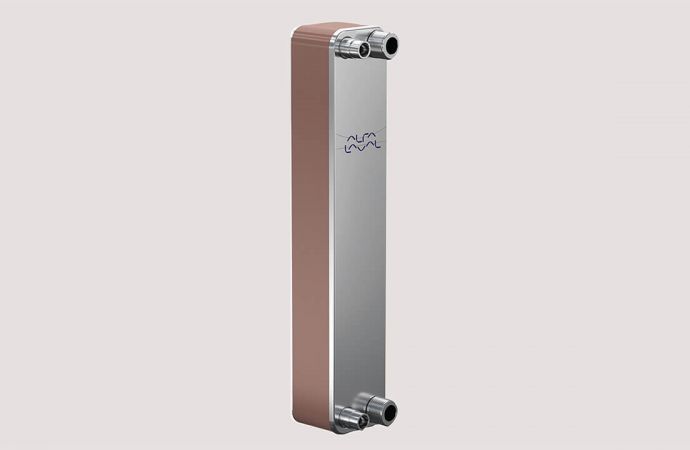Greater charges will mean fewer components, and a less expensive system.

Along with transcritical CO2, hydrocarbons, primarily propane (R290), have emerged in the last several years as a viable refrigerant for supermarkets.
Thousands of stores worldwide have deployed plug-in air-cooled R290 display cases at the point-of-sale or in other spot merchandising capacities.
On top of that, a growing number of supermarkets, usually on the smaller side, have been installing water-loop R290 case lineups throughout their frozen-food sections, or the entire store.
These trends are expected to continue apace in 2021.
Moreover, the higher charge limit (500g, up from 150g) approved for R290 in commercial cases by the International Electrotechnical Commission (IEC) last year is now being adopted in varying degrees by regional standards bodies. This is expected to spark further adoption of R290 systems as single-circuits will be able to replace multiple circuits in larger cases.
“The simpler the system, the better it will fare, and R290-based systems fit that niche,” said Joe Kokinda, President/CEO, Professional HVAC/R Services, a U.S. contractor for food retailers.
R290 systems are becoming more and more variable in style, “with motors and compressors ramping up and down as needed,” said Kokinda. “This will be beneficial to the end users on energy use, but the initial cost is much higher.”
However, if R290-operated equipment can be used with higher charge limits, it will mean “[fewer] refrigeration cycle components, fewer compressors, and that can lower the cost of the final product,” said Donatas Plauska, Head of Sales Department for Lithuanian OEM Freor.
Kokinda observed that many independent retailers, while “flush with cash” from COVID-19 sales bumps, are still “dragging their feet on CO2” installations. Instead, most are looking at hydrocarbon units, he said, adding, “We have seen that gain traction in California.”
But Kokinda also pins further growth in hydrocarbon units on the adoption of higher charge limits by regional authorities. “Not many customers see the benefit in cabinets that have more than one compressor, which I agree with,” he said.
James Knudsen, Vice President of Sales, Kysor Warren Epta, believes that plug-in R290 cabinets represent the natural refrigerant application with greatest opportunity in 2021, followed by water- loop R290 systems for small venues and remodels, and transcritical CO2 for new and remodeled central systems.
Hannaford, a chain in the northeast U.S., has been testing water-loop R290 low-temperature cases in new stores. Now the retailer is considering installing them in existing stores in a retrofit. “We have a couple of existing stores we’re looking at for next year,” said Joshua Smith, Manager of Refrigeration & HVAC Service, Hannaford. The roof of these stores would have to support a fluid cooler, he noted.
In one new store in Vermont (U.S.), Hannaford has installed an R290 low-temperature lineup with a transcritical CO2 glycol chiller for medium-temperature cases. The combination of R290 frozen-food cases and secondary glycol medium-temperature cases represents “a significant improvement over what we have, and moves us toward the end game,” said Harrison Horning, Director of Energy & Facilities, Hannaford.
Other U.S. retailers exploring R290 lineups include ALDI US, which said it anticipates testing AHT Cooling Systems USA's R290 semi-plug-in cases with water-loop cooling, as well as air-cooled R290 display cases and cold-room packaged units. AHT is also planning an installation at a Piggly Wiggly store in Georgia in which “our R290 water-loop [cases] were selected over traditional D X r emote for a multi-use retail project,” said Drew Tombs, President, AHT Cooling Systems USA.
In Belgium, Colruyt Group aims to eventually convert all of its stores to R290 refrigeration. The number of R290 stores was expected to rise to 132 by the end of the 2020, out of 413 stores in total (mostly in Belgium), Collin Bootsveld, Project Engineer, Colruyt Group. “All new systems will have natural refrigerants and we will continue to convert existing HFC equipment in 2021,” he said.
Colruyt uses an unconventional R290 system, which comprises two or three “ventilated enclosure” compact R290/glycol chillers, depending on the size of the store. They serve a cold room open to shoppers for produce, dairy and other medium-temperature products; they also support the butcher/deli in the main store area. Stand-alone chest freezers employ isobutane (R600a) or R290 as the refrigerant.
Freor expects to see a growing number of R290 plug-in refrigerated cabinets in tandem with water-loop systems for small to medium stores, and CO2 remote systems for large sales areas, in the coming years, said Plauska at Freor. “R290 will be dominating plug-in and semi plug-in showcases, especially with higher charge limits under a revised standard in commercial refrigeration in Europe.”
Freor is expanding its R290 product line to accommodate the new IEC charge limit for R290 of up to 500g. “We also invest in developing more energy-efficient refrigerated display cabinets,” said Plauska.
R290 cases offer “space-saving, lower installation, and maintenance costs, and the possibility for residual heat reuse, [which] is becoming more and more important for store owners,” said Plauska.
Though the foodservice industry has struggled this year because of the COVID-19 pandemic, it was already turning significantly toward the adoption of R290 fridges and freezers. True Manufacturing, a major provider to both foodservice and retail outlets, has “already converted to hydrocarbons on all products,” said Todd Washburn, Director Sales & Marketing – Retail Division. “So for True, this is a done deal.”
R290 technology is mature and already very efficient, and R290 components are already scaled to volume, noted Washburn, adding, “Pricing in the market is parity to legacy HFC.”
But the market will continue to see component manufacturers and cabinet manufacturers pushing for product improvements in a competitive environment, Washburn said.
In China, the adoption of hydrocarbon cases has been slow, though some local supermarkets have installed water-loop systems this year, said Du Li Li, Overseas Sales Director, Panasonic Appliances Refrigeration System (Dalian) Co., Ltd.
David Zhang, Owner of Shanghai Fute Refrigeration & Electrical Engineering Co, Ltd, is not optimistic about the use of hydrocarbon cases in China, “unless it is proven that the cost of using hydrocarbons as a refrigerant product is competitive, and the safety of use and maintenance is guaranteed.”
In Japan, where CO2 outdoor condensing units have long been popular in the commercial refrigeration sector, hydrocarbon-based systems have made significant progress, and this trend is expected to continue in 2021.
In 2020, on the trade show floors of Japan’s two largest food retail and food service exhibitions, Supermarket Trade Show (SMTS) and HCJ, several of Japan’s biggest names in commercial refrigeration exhibited hydrocarbon equipment aimed at the Japanese market for the first time.
Major Japanese end users are also taking notice and implementing the hydrocarbon-based equipment. In September, Japanese convenience store chain Lawson opened its first freon-free store, where it is using hydrocarbons for the first time for its smaller plug-in upright and under-counter refrigerators and ice makers.
Japanese OEM Hoshizaki, which has long been a provider of hydrocarbon equipment overseas, supplied hydrocarbon plug-in equipment for the first time in Japan at the Lawson store.
This article is excerpted from one appearing in “Cooling in 2021,” Accelerate Special Issue #112.
The simpler the system, the better it will fare, and R290-based systems fit that niche.” - Joe Kokinda, Professional HVAC/R Services
Related stories





